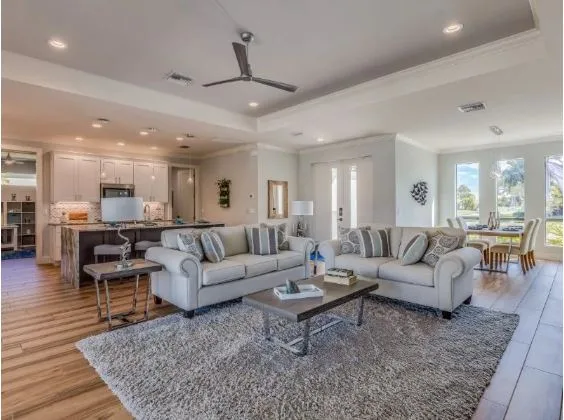Which manufactured home floor plans maximize living space?
If you’re shopping for a manufactured home, you’ve probably noticed that the same listed square footage can feel very different from model to model. That’s because layout beats raw size when it comes to everyday comfort. The best manufactured home floor plans turn every inch into something useful: clear traffic paths, storage where you actually need it, rooms that do double duty, and natural light that makes everything feel bigger. Below, we’ll break down the layouts and features that consistently maximize living space—so you can spot a smart plan the moment you step inside.
What “maximize living space” really means
Maximizing space isn’t just about squeezing in more rooms. It’s about usable space—areas that are easy to furnish, simple to navigate, and comfortable to live in. Two homes can have identical dimensions, but the one with fewer hallway bottlenecks, better storage, and smarter room placement will feel larger. When evaluating manufactured home floor plans, look beyond the headline square footage and ask:
- Is the traffic flow intuitive, with minimal dead-end corners?
- Do rooms have at least one full wall that fits real furniture?
- Is storage near the action (pantry by the kitchen, linen by the bath, coats by the entry)?
- Does the plan borrow light with windows or transoms to open sightlines?
Seven layout principles that create “more room” without adding square feet
- Open core, defined edges. A combined living–dining–kitchen makes the heart of the home feel expansive, but you still want visual cues (an island, a ceiling beam, a change in flooring) to subtly define zones.
- Split bedrooms for privacy. Put the primary suite on one side and secondary bedrooms on the other. You’ll gain quieter sleeping spaces and a more usable central living area, because you’re not routing traffic through bedrooms.
- Shorter, smarter halls. Long hallways eat space. Great plans turn halls into “service spines” that also host closets, a niche desk, or a stacked laundry.
- Right-sized rooms. Oversizing one room steals from others. Aim for living rooms that comfortably fit a sofa, two chairs, and a media wall; bedrooms that hold a queen bed and two nightstands with walking clearance.
- Storage you can actually reach. Walk-in pantries, linen closets close to baths, coat storage at the entry, and a mud bench by the back door all reduce clutter and make rooms feel bigger.
- Multiple-use flex areas. A pocket office off the kitchen, a dining nook that becomes a homework zone, or a den that converts to a guest room multiplies function without increasing the footprint.
- Light and sightlines. Windows placed at the ends of sightlines—across from the entry or at the back of the living room—stretch the perceived depth of the home.
The most space-efficient manufactured home floor plans (and why they work)
1) Open-concept with a central island kitchen
This is a classic because it eliminates redundant walls and creates a large, flexible “great room.” The kitchen island doubles as prep space, a breakfast bar, and a buffet when entertaining. With fewer interior partitions, furniture placement is simpler and traffic flows naturally around the island rather than through seating zones. Look for an island around 6–8 feet with legroom on one side and concealed trash/recycling on the other.
Best for: Households that entertain, families who want line-of-sight to kids, anyone who prefers a bright, airy feel.
2) Split-bedroom double-wide with front living
In this plan, you enter into the living room with the primary suite on one side and two bedrooms on the other. The kitchen and dining are centered. This arrangement removes cross-traffic through private spaces and makes the central area the hub—ideal for daily life. When evaluating similar manufactured home floor plans, choose the version with a hall bath accessible from the main area so guests never cut through a bedroom.
Best for: Privacy between generations, shift workers, roommates, or anyone who values a quiet primary retreat.
3) End-living single-wide with expanded window wall
Single-wides can feel narrow, but placing the living room at the end with a wide window set or patio door dramatically increases perceived space. Pair it with a galley or L-shaped kitchen adjacent to the living area and a short hall to the bedrooms. Because the living room uses the full width of the home, it becomes easy to fit real furniture and a media wall without awkward angles.
Best for: Compact sites and first-time buyers who want a small home that lives large.
4) L-shaped kitchen with pocket pantry and dining nook
If you prefer a defined cooking zone, an L-shaped kitchen that tucks the fridge and range along perpendicular walls keeps the work triangle tight and frees up the center for a true dining table. Add a pocket pantry (3–4 feet wide) that slides behind the fridge wall for bulk storage without sacrificing floor area. The result is a kitchen that cooks like a bigger one while the adjacent dining nook flexes for work or crafts.
Best for: Home cooks, bakers, and households that need a full table regularly.
5) Flex-room 3-bed/2-bath with convertible den
Many 3/2 plans include a den or “retreat” space near the secondary bedrooms. Choose a layout with double doors to the den and an optional closet. With a sleeper sofa and a fold-down desk, it becomes a guest room, playroom, or office as needed. You effectively gain a fourth “use” without adding another bedroom.
Best for: Growing families, multigenerational living, or remote workers who occasionally host guests.
6) Utility/mudroom buffer with exterior door
Space often vanishes to clutter. A plan that includes a mudroom with hooks, cubbies, and a bench right off a side or back door keeps shoes, bags, and pet gear contained. The nearby laundry reduces trips across the house and frees the kitchen from doubling as a drop zone. Bonus points for a half-bath off this area, so outdoor messes never reach the main living space.
Best for: Households with kids, pets, hobbies, or anyone in muddy/snowy climates.
7) Primary suite with vestibule and back-to-back plumbing
A tiny “vestibule” at the primary suite entry creates privacy without adding much square footage. Position the primary bath back-to-back with the hall bath to consolidate plumbing walls—this saves cost and frees more space for a larger shower or extra linen storage. Choose a bath with a single, generous vanity over cramped duals; counter space and drawers make a bathroom feel bigger day-to-day.
Best for: Owners who want a retreat that still fits real storage.
Storage and built-ins that make rooms feel bigger
- Pantry over extra cabinets. A true pantry swallows appliances, bulk items, and lunchboxes so countertops stay clear.
- Wall-to-wall media niche. Plan a full media wall rather than scattering furniture; it gives the living room a strong focal point and consolidates storage.
- Bedroom built-ins. Shallow wardrobes or drawers flanking the bed free a closet for off-season items.
- Window benches. A bench with hidden storage below a living room or dining window adds seating without the visual bulk of more chairs.
- Tall cabinets. Stretch kitchen uppers to the ceiling. You’ll gain a shelf for seldom-used items and avoid dust-catching gaps.
Room-by-room tweaks that open things up
Entry: A small coat closet or cubby wall at the front door instantly declutters. If space is tight, a 36-inch console with drawers plus a mirror doubles as a key drop and last-look station.
Living room: Aim for at least one 12–14-foot uninterrupted wall for seating or a media center. Float the sofa—don’t shove everything against walls—and use a 5×8 or 8×10 rug to visually anchor the zone.
Kitchen: Keep aisle widths efficient: 42 inches between counters in work zones, 48 inches if the fridge opens into it. Choose drawers for base cabinets; they hold more and are easier to access.
Dining: If you rarely host big dinners, choose a round table (it tucks in tighter) and expand with a leaf when needed.
Baths: Pocket doors can recover 10–14 square feet of swing clearance. Niches in the shower corral bottles without wire racks.
Bedrooms: Place windows to accommodate a bed wall; off-center windows force awkward furniture layouts.
Buying and customization tips to find the most efficient plan
- Walk it with furniture in mind. Picture your actual sofa, dining table, and bed sizes. Can you open drawers and doors without collisions?
- Ask about options that add function, not just finishes. A pantry, pocket doors, or added windows will change daily life more than upgraded countertops.
- Prioritize lighting and outlets. Prewire for ceiling fans and ensure you have outlets where you’ll charge devices or place lamps to avoid cords crossing pathways.
- Consider future flexibility. If your household may grow or shift, pick manufactured home floor plans with a flex room or a larger dining area that can adapt.
- Don’t over-upgrade bathrooms. Two smaller baths can feel cramped; invest in one excellent shower and better storage instead.
Quick checklist when comparing models
- Open central living with clear sightlines
- Split-bedroom layout (primary separate from secondary)
- Short, useful hallways (with storage or desk niches)
- Real pantry + coat/linen storage in logical places
- Utility/mudroom with exterior door and hooks/bench
- Flex room with closable doors (ideally near a hall bath)
- Windows placed to frame views and lengthen sightlines
- At least one full-length wall in the living room and each bedroom
The bottom line
Square footage matters, but layout matters more. The manufactured home floor plans that truly maximize living space share the same DNA: an open, multi-use core; smart storage near the action; short, productive hallways; and private, right-sized bedrooms. Whether you’re choosing a single-wide with an end living room or a split-bedroom double-wide with a central island kitchen, use the principles above to evaluate how the home will work for your daily life. With a sharp eye for flow, storage, and light, you’ll find a plan that lives bigger than its dimensions—and feels right from day one.





